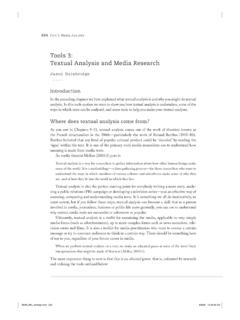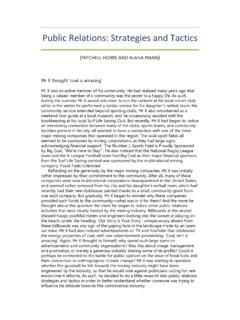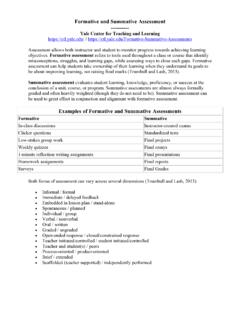Transcription of A Positive Learning Framework for Classroom Management
1 11A Positive Learning Framework for Classroom ManagementLearner outcomesAfter reading this chapter, you should be able to: understand the foundations of the Positive Learning Framework describe the need for a Positive focus on student behaviour begin to explore a developmental or needs-based Framework in working with students explain the need for teachers to articulate assumptions, beliefs and mental models in teaching appreciate the role of environment in influencing behaviour and meeting individual needs briefly explain the key concepts and research underpinning a strength-based termsattachmentautonomyclassroom managementcompetencemental modelspsychological needsquality teachingresilienceself-esteemsocial and emotional developmentstrength-based approachSample only Oxford University Press ANZC lassroom Management2 DeveLoPing A Positive Learning FrAMeworkIn Australia, Classroom Management and student engagement are significant issues for teachers, school leaders, system administrators and the public.
2 They heavily affect community perception, teacher efficacy and well-being, and the standards of achievement of students including misbehaving students . As a practising or beginning teacher , I am sure student behaviour is of prime concern for you and will continue to be as you progress through your teaching career. The outcome of working through this text is for you to develop an approach that will enable you to develop a working language of discipline and to respond to student behaviour in a Positive and effective manner to preserve the dignity of the young person while engaging them in come to school with a great diversity of backgrounds, interests and capabilities. Meeting their needs and engaging them in meaningful Learning requires care and skill.
3 One of the first tasks of teaching is to develop an orderly Learning environment so that students can engage in meaningful activities that support their Learning . Teachers who are able to engage students in this Learning are those who have a Management plan that begins before the students arrive. An orderly Learning environment exists because teachers have clear ideas of the type of Classroom they want and of acceptable student behaviours that assist Learning . Once the class begins, effective teachers work very hard to create this quality Learning environment. This book outlines a Framework that includes skills and strategies to support you to create a quality Learning chapter introduces you to the Positive Learning Framework (PLF) for Classroom Management .
4 We also introduce you to the key constructs that underpin this Framework from a strength-based model of working with students in a school setting. The Framework is based on current resilience, self-worth, and neurological research and Positive psychology, which highlight the strengths that students have and how, as educators, we can draw upon these strengths in assisting all children to benefit of a strength-based model for education is that it builds upon the personal competencies associated with healthy development that each individual has. A strength-based approach identifies the resourcefulness and resilience that exists in all students . In focusing on the Positive , this approach Sample only Oxford University Press ANZCHAPter 1: A Positive Learning Framework for Classroom Management 3helps teachers to reframe how they see students and to view behaviour from a different perspective, as well as to recognise the incredible resilience of students , especially those facing immense challenges in their lives.
5 Recent psychological research has focused on deficit, disorder and damage, and the study of what makes life worth living has receded into the background. Positive psychology ( ) offers a revival of early youth pioneers who saw the Positive in all young people. Martin Seligman is a world leader in the Positive psychology movement and was the president of the American Psychological Association and a leader in optimism research. Positive psychology is the study of the conditions and processes that contribute to the flourishing or optimal functioning of people, groups and institutions (Gable & Haidt, 2005). For educators this is a good place from which to view behaviour as it enables motivations and needs to be addressed, rather than focusing on a deficit mentality, which views the child or family as at fault and does not recognise the environment or processes of interaction between student and tHree PHAses oF tHe Positive Learning FrAMeworkThe PLF offers a continuum of teacher behaviours from pre-class planning to in-class teaching, incorporating how to respond to student behaviour.
6 Often teacher education courses focus on isolated approaches to curriculum, instruction or Management . It is left up to the pre-service teacher to put this all together to form a whole package of teaching . The very nature or structure of these courses (and one-off professional Learning sessions) assists in atomising teaching skills and concepts. In developing a personal approach to teaching, pre-service and in-service teachers are required to integrate information from numerous sources, some of which may be at odds with each other and all of which may claim to have the answer! The Positive Learning Framework , on page 4, offers a thorough evidenced-based synthesis of current knowledge in effective Classroom Management and instruction.
7 The three phases of the Framework begin with preparing to teach, then move to actual Classroom teaching and finally to correcting student Sample only Oxford University Press ANZC lassroom Management4 Prevention: self-awareness and Management PlanPrevention: lesson designCorreCtive aCtionsAt the start of the year and before each class self-awareness proactive thinking indiscipline will happen at some stage caring and welcoming Classroom Classroom layout and resources high and specific expectations rules, routines and proceduresBeginning whole-class attention (Cue to Start) clear outcomes conveyed to students motivation hook for Learning set induction advanced organiser recall prior Learning level of student engagementLow-level responses (minimal/no disruption to lesson flow) use of dignity (privacy/ politeness/tone of voice) minimal language (use succinct messages, an assertive tone with eye contact, avoid why questions, redirect to lesson)
8 Proximity name and thanks look/eye contact non-verbal communication/gestures/signals redirection defer to private catch-up later clear desists tactical ignoringdiscipline in order to encourage Learning . Incorporated into the approach are the practical skills and strategies used by teachers to prevent and respond to student indiscipline. Applying the PLF across a school assists in developing consistent quality Learning environments throughout the school. The three phases are outlined in brief below, and the rest of the text will explain each section in teaching and prevention of student indiscipline are key ingredients to successful student engagement in Learning . The first phase begins with preparation before the class begins.
9 One crucial ingredient in this prevention and preparation phase is how we not only prepare the Learning environment but also how we prepare ourselves for the type of Learning and Classroom we are developing. How do I, as the teacher , prepare for the elements listed in this phase? I need to think about these elements before they happen! This is all before I start planning the lesson and how I will teach Learning Framework three-phase modelSample only Oxford University Press ANZCHAPter 1: A Positive Learning Framework for Classroom Management 5 During lessons connecting C2S managing student movement with-it-ness acknowledgment of appropriate behaviour opportunities for autonomy and responsibilityMiddle teaching/ Learning strategy active student involvement collaborative Learning strategies group work student movement for distribution of resources questioning and responding to student answers and effort promoting student successModerate-level responses circle-time.
10 Conferencing identifying motivation identifying the game empathetic statements offering escape routes offering choices giving student responsibility for actionsEnding/closure check for understanding against outcome evaluation expectations lesson summary link Learning to outside of Classroom next lesson what we will be doing next lesson is .. teacher reflection on impact on all student learningEscalating/crisis response awareness of escalation phase de-escalation/defusing strategies crisis-response strategiesRestorative responses skills for connecting, clarifying and restoring relationshipsAlongside your personal and professional preparation before class, you need to plan how you will teach. The lesson design phase of this model is deliberately simple and distils the main elements of a lesson.













